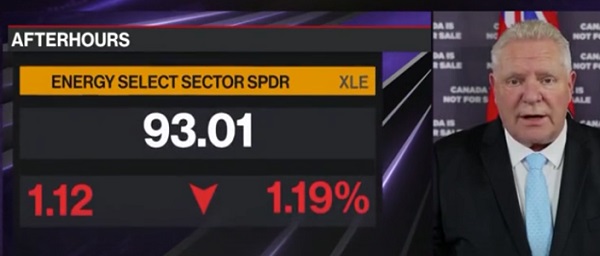Alberta
Former Chief Judge of Manitoba Proincial Court will lead AHS third-party investigation into AHS procurement process

Deputy Minister of Jobs, Economy and Trade Christopher McPherson has issued the following statement on an independent third-party investigation into procurement and contracting processes used by the Government of Alberta and Alberta Health Services (AHS):
Deputy Minister of Jobs, Economy and Trade Christopher McPherson has issued the following statement on an independent third-party investigation into procurement and contracting processes used by the Government of Alberta and Alberta Health Services (AHS):
“While serving as Acting Deputy Minister of Executive Council, Premier Danielle Smith asked me to establish a credible, independent, third-party investigation into the procurement processes used by the Government of Alberta and AHS and their outcomes.
“I have informed Premier Smith that the Honourable Raymond E. Wyant, former Chief Judge of the Provincial Court of Manitoba, will lead this investigation. I asked Premier Smith to issue a ministerial order to facilitate his work and she has done so. Judge Wyant’s work on this matter begins immediately.
“Judge Wyant was appointed to the Manitoba bench in 1998 before becoming Chief Judge in 2002. Prior to his service on the bench, Judge Wyant worked as a criminal defence lawyer and Crown attorney and was acting deputy director of Manitoba prosecutions at the time of his appointment to the Bench. He has also taught law for many years at Robson Hall at the University of Manitoba.
“Judge Wyant will review the relevant legislation, regulations and policies related to procurement typically used by Government of Alberta departments and agencies, specifically AHS, and their application to the procurement of pharmaceuticals and to services offered by chartered surgical facilities. Questions that Judge Wyant will consider are outlined in the attached terms of reference, and include whether or not any elected official, Government of Alberta or AHS employee, or other individuals, acted improperly during the procurement processes. Judge Wyant will make recommendations to the government for improvement or further action as appropriate.
“Appointed under the Government Organization Act, Judge Wyant will operate independently of government. The Government of Alberta will provide Judge Wyant with access to all relevant documents held by its departments and AHS, as well as facilitate interviews with relevant individuals.
“Judge Wyant has been given a budget of $500,000 to undertake this important work, including to retain legal and audit assistance at his discretion. He is being paid $31,900 per month, which is the same remuneration rate as the Chief Justice of the Alberta Court of Justice.
“To ensure additional independence, Service Alberta and Red Tape Reduction will hold the budget for this third-party investigation.
“Judge Wyant will deliver an interim written report by May 30, 2025. A final written report and recommendations will be delivered by June 30, 2025, and it will be posted on alberta.ca.”
Related information
Alberta
Big win for Alberta and Canada: Statement from Premier Smith

Premier Danielle Smith issued the following statement on the April 2, 2025 U.S. tariff announcement:
“Today was an important win for Canada and Alberta, as it appears the United States has decided to uphold the majority of the free trade agreement (CUSMA) between our two nations. It also appears this will continue to be the case until after the Canadian federal election has concluded and the newly elected Canadian government is able to renegotiate CUSMA with the U.S. administration.
“This is precisely what I have been advocating for from the U.S. administration for months.
“It means that the majority of goods sold into the United States from Canada will have no tariffs applied to them, including zero per cent tariffs on energy, minerals, agricultural products, uranium, seafood, potash and host of other Canadian goods.
“There is still work to be done, of course. Unfortunately, tariffs previously announced by the United States on Canadian automobiles, steel and aluminum have not been removed. The efforts of premiers and the federal government should therefore shift towards removing or significantly reducing these remaining tariffs as we go forward and ensuring affected workers across Canada are generously supported until the situation is resolved.
“I again call on all involved in our national advocacy efforts to focus on diplomacy and persuasion while avoiding unnecessary escalation. Clearly, this strategy has been the most effective to this point.
“As it appears the worst of this tariff dispute is behind us (though there is still work to be done), it is my sincere hope that we, as Canadians, can abandon the disastrous policies that have made Canada vulnerable to and overly dependent on the United States, fast-track national resource corridors, get out of the way of provincial resource development and turn our country into an independent economic juggernaut and energy superpower.”
Alberta
Energy sector will fuel Alberta economy and Canada’s exports for many years to come

From the Fraser Institute
By any measure, Alberta is an energy powerhouse—within Canada, but also on a global scale. In 2023, it produced 85 per cent of Canada’s oil and three-fifths of the country’s natural gas. Most of Canada’s oil reserves are in Alberta, along with a majority of natural gas reserves. Alberta is the beating heart of the Canadian energy economy. And energy, in turn, accounts for one-quarter of Canada’s international exports.
Consider some key facts about the province’s energy landscape, as noted in the Alberta Energy Regulator’s (AER) 2023 annual report. Oil and natural gas production continued to rise (on a volume basis) in 2023, on the heels of steady increases over the preceding half decade. However, the dollar value of Alberta’s oil and gas production fell in 2023, as the surging prices recorded in 2022 following Russia’s invasion of Ukraine retreated. Capital spending in the province’s energy sector reached $30 billion in 2023, making it the leading driver of private-sector investment. And completion of the Trans Mountain pipeline expansion project has opened new offshore export avenues for Canada’s oil industry and should boost Alberta’s energy production and exports going forward.
In a world striving to address climate change, Alberta’s hydrocarbon-heavy energy sector faces challenges. At some point, the world may start to consume less oil and, later, less natural gas (in absolute terms). But such “peak” consumption hasn’t arrived yet, nor does it appear imminent. While the demand for certain refined petroleum products is trending down in some advanced economies, particularly in Europe, we should take a broader global perspective when assessing energy demand and supply trends.
Looking at the worldwide picture, Goldman Sachs’ 2024 global energy forecast predicts that “oil usage will increase through 2034” thanks to strong demand in emerging markets and growing production of petrochemicals that depend on oil as the principal feedstock. Global demand for natural gas (including LNG) will also continue to increase, particularly since natural gas is the least carbon-intensive fossil fuel and more of it is being traded in the form of liquefied natural gas (LNG).
Against this backdrop, there are reasons to be optimistic about the prospects for Alberta’s energy sector, particularly if the federal government dials back some of the economically destructive energy and climate policies adopted by the last government. According to the AER’s “base case” forecast, overall energy output will expand over the next 10 years. Oilsands output is projected to grow modestly; natural gas production will also rise, in part due to greater demand for Alberta’s upstream gas from LNG operators in British Columbia.
The AER’s forecast also points to a positive trajectory for capital spending across the province’s energy sector. The agency sees annual investment rising from almost $30 billion to $40 billion by 2033. Most of this takes place in the oil and gas industry, but “emerging” energy resources and projects aimed at climate mitigation are expected to represent a bigger slice of energy-related capital spending going forward.
Like many other oil and gas producing jurisdictions, Alberta must navigate the bumpy journey to a lower-carbon future. But the world is set to remain dependent on fossil fuels for decades to come. This suggests the energy sector will continue to underpin not only the Alberta economy but also Canada’s export portfolio for the foreseeable future.
-

 2025 Federal Election2 days ago
2025 Federal Election2 days ago‘I’m Cautiously Optimistic’: Doug Ford Strongly Recommends Canada ‘Not To Retaliate’ Against Trump’s Tariffs
-

 Business2 days ago
Business2 days agoCalifornia planning to double film tax credits amid industry decline
-

 Business2 days ago
Business2 days agoCanada may escape the worst as Trump declares America’s economic independence with Liberation Day tariffs
-

 Alberta2 days ago
Alberta2 days agoBig win for Alberta and Canada: Statement from Premier Smith
-

 Catherine Herridge2 days ago
Catherine Herridge2 days agoFBI imposed Hunter Biden laptop ‘gag order’ after employee accidentally confirmed authenticity: report
-

 Business1 day ago
Business1 day agoB.C. Credit Downgrade Signals Deepening Fiscal Trouble
-

 COVID-1923 hours ago
COVID-1923 hours agoTrump’s new NIH head fires top Fauci allies and COVID shot promoters, including Fauci’s wife
-

 2025 Federal Election2 days ago
2025 Federal Election2 days agoLiberal MP resigns after promoting Chinese government bounty on Conservative rival







